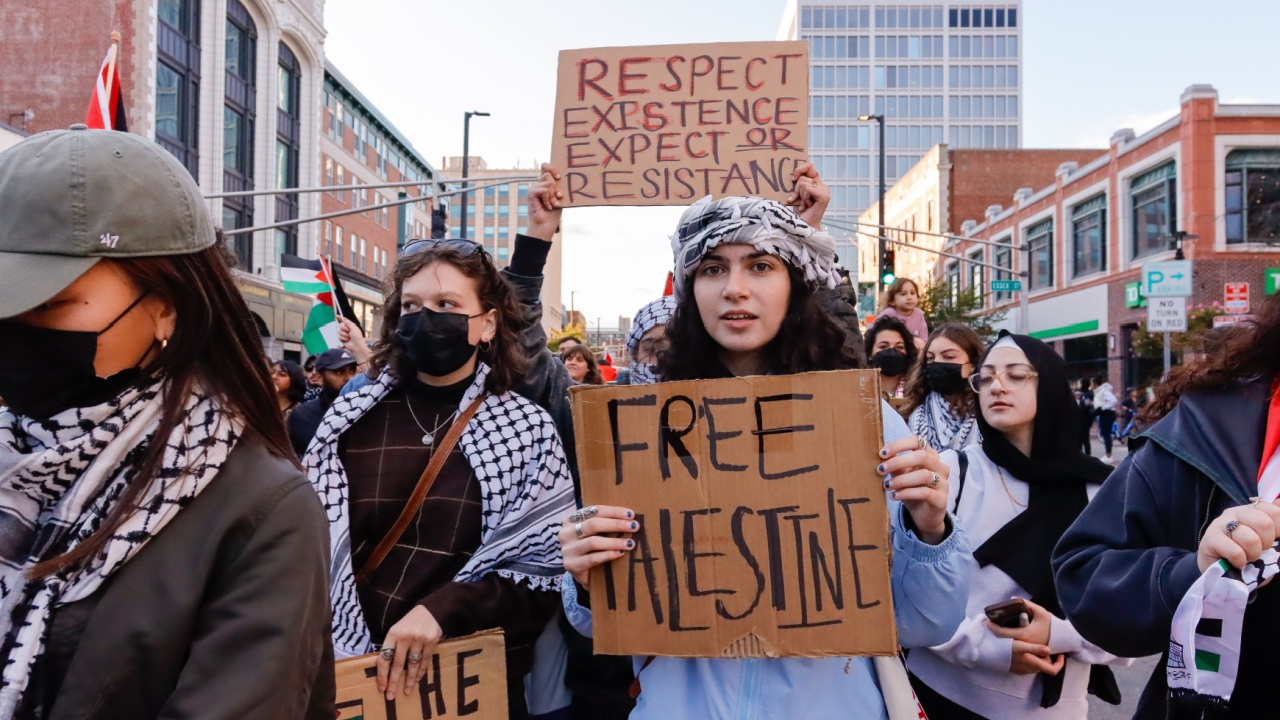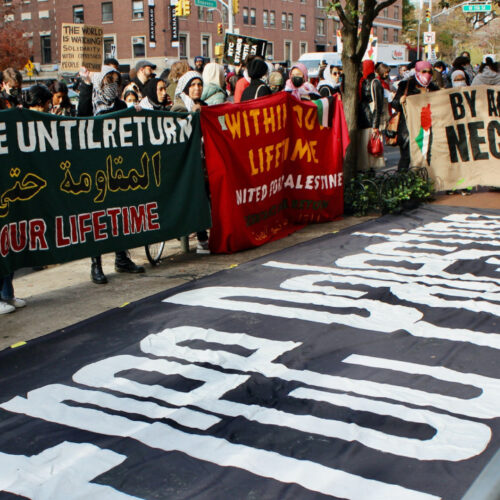Three Pillars of Education

Editor’s Note: Nowhere has the group quota regime been more successful in its early years than in higher education, where the ideology of outcome equality is mandatory both as doctrine and as practice. A recent exchange in Public Discourse between Robert George and Yoram Hazony considered whether free speech is still a viable or desirable ideal in this era of the woke university. Here, Peter Wood, the president of the National Association of Scholars, argues alongside Hazony that free speech cannot be the highest principle of education — that firmer groundings and loftier aims are necessary in the fight against a revolutionary enemy.
As Wood writes,“Real intellectual diversity, the hierarchy of knowledge, the integrity of the individual, civility, and the pursuit of truth have all been captured by the radical left and turned inside out. We win this war only if we realize that education itself is at stake.”
If I had been asked a year ago about free speech on campus and the doctrine of “institutional neutrality,” I would have given an answer markedly different from what I give today. Not that I would have lined up with those who elevate “free speech” to be the highest principle—or the deepest foundation—of higher education. The intellectual heirs of John Stuart Mill say such things frequently and with firm assurance. Mill’s great essay, On Liberty, is their Mount Ararat. It towers over the landscape littered with discarded speech codes, debunked theories, and zealous enforcers of rules against bias. Just as certain religious enthusiasts believe Noah’s ark came to rest on the top of the Turkish mountain, certain free speech advocates anchor themselves on Mill’s idea that the truth can be approached by holding the doors of academe wide open to any and all views.
This is essentially the position taken by Robert George in his debate with Yoram Hazony in Public Discourse. Hazony, by contrast, cites Mill with an attitude of weary disdain. He says American universities love Mill’s idea that the “free exchange of divergent ideas will eventually lead society to truth and virtue.” Hazony adds, “Indeed, the belief that free inquiry is the only road to truth has been promoted as the principal dogma of the postwar liberal university for nearly sixty years—since the ‘free speech’ movement of the 1960s.”
But Hazony observes that “something has obviously gone wrong.” He refers to the eagerness of many faculty and students to endorse the unspeakable atrocities of October 7. Does the free exchange of “ideas” mean that sensible academics who uphold Mill’s teaching should make peace with the idea that extolling mass murder, rape, and other barbarities is just another point of view that should be welcomed to the discussion? That the pursuit of truth would be harmed if we failed to offer, politely, a seat at the seminar table to Hamas apologists?
I was on Hazony’s side well before I read his February 11 essay. And for some of the same reasons. I had been pointing out in essays I wrote in the wake of the massacre that “academic freedom” could not be bent to accommodate excuses for and provocation for mass murder—at least not without vitiating the concept of academic freedom itself.
I began my journey away from Mill’s doctrine in 2016 in a long essay, “The Architecture of Intellectual Freedom,” which has enjoyed a fair amount of success in the years since. The essay makes two major arguments. The first is that “academic freedom” must be distinguished carefully from “free speech,” the First Amendment, and intellectual freedom. That’s because academic freedom is a doctrine that pertains to the particular circumstances of the college or university. Within those circumstances, it guarantees certain rights of expression to faculty members and students—but not unlimited freedom of expression, or indeed, unlimited intellectual freedom.
The other major argument is that academic freedom is not the only foundational doctrine of the university. It sits beside other key ideas, such as the need for debate on some fundamental subjects (which is close to Mill’s point) but also the recognition that the purpose of higher education is indeed education, not debate for its own sake. With this comes the understanding that the university is built on a hierarchy of knowledge. Colleges have to choose what courses to offer and what not to offer, and to distinguish, one way or another, between the important and the trivial. Academic freedom is no license to teach Edward Lear’s Complete Nonsense as the literary, moral, intellectual, or aesthetic equal of Shakespeare’s Sonnets. Yet, of course, American higher education today is rife with courses that treat works much less worthy than Edward Lear’s rhymes as deserving the rapt attention of undergraduates.
The foundational doctrines of higher education that go beyond academic freedom include three more that do not usually get the same level of attention accorded to Mill’s precept.
One is the integrity of the individual. The ability that Mill rightly attributes to us to make up our minds rests on the more fundamental idea that education depends on the individual gaining enough perspective to resist intellectual conformity for its own sake. Today, our faculty have turned the idea of “academic freedom” into a license to influence vulnerable minds into the “safety” of collective agreement on many of the issues that should be treated with the greatest reserve. How else to explain the willingness of striking majorities of students on campuses across the country to shut down the expression of unsanctioned views? In most cases those students do not disagree with the views they censor. They don’t know enough about them to disagree. All they know is that these views are somehow “wrong.”
“Civility” is yet another pillar of higher education. This one has recently re-emerged from the fog as desperate defenders of the pro-Hamas factions claim that civility requires that Hamas apologetics must be treated with the same courtesy we might extend to those who defend the rights of vegans to their own meal plans. Some people want a meat-free diet; some want to kill Jews. The campus is a gloriously tolerant place.
True civility is a social contract that requires all who would wish for a place on campus to accede to the authority of the institution to set and enforce rules. Dissent can be tolerated, but dissent that descends into incivility (or worse) must be met with sanctions.
The last but most important pillar of education is the pursuit of truth. This, it must now be said, entails the notion that truth exists and is to some degree knowable. The pursuit of truth puts us on perilous ground, since it is so common for we humans to mistake widespread or attractive opinions for truth, and to back those opinions with the exercise of power. Mill and his latter day exponents are vividly aware of this danger—so aware that they often tip over the precipice into postmodern freefall, when any claim to truth is ridiculed as a mere exercise of power.
With these thoughts in mind, I met the outbreak of moral cowardice among college officials in the wake of October 7 fully expecting a season of moral preening and self-exculpation in the name of “free speech.” I likewise anticipated that many of the organizations that defend, promote, and celebrate “free speech” would also join the refrain. It goes something like this: We cannot give into moral panic. Yes, the anti-Semitism on display is bad. But much worse would be to lose our bearings and sacrifice our deepest (or highest!) principle of free speech.
Because I head an organization that has spent decades defending academic freedom, I know the leaders of almost all the other groups that have related ideals. But that also makes me keenly aware of the distinctions. I never regarded academic freedom, or free speech, as the be-all, end-all of education. It has its place, but when academic freedom obstructs actual education, we need to step back to consider the larger picture.
Hazony’s essay, “Should Universities Protect Campus Anti-Semites?” displays exactly that kind of stepping back. He recognizes that figures such as Jonathan Haidt and Robert George who call for a fair-minded presentation of the full “range of perspectives” are proposing a fool’s errand. No full range of perspectives is possible in an institution “dominated by ideological monoculture.”
Hazony spends a bit too much of his essay fondly recalling the marginally better time of his undergraduate youth at Princeton in the 1980s. Was it really better? The National Association of Scholars was founded officially in 1987, and had been gathering itself less formally for four or five years before that. It was summoned into existence by liberal academics (all of them Democrats) who were sufficiently alarmed by the rising power of illiberal and radical faculty to foresee a cultural catastrophe if that development were to continue unopposed. Just as Hazony points out, Robert George was one of the heroes of the newly founded resistance.
What has happened in the intervening decades? One way of putting this is that Professor George is still fighting the battle he joined back then, but now he fights like one of those isolated Japanese soldiers left behind in the Philippine jungle years after the Imperial Army went down to defeat. It is a different war today, and warm relationships with Cornel West and Peter Singer mean nothing at all for the future of liberal education, at Princeton in particular or in America in general. Real intellectual diversity, the hierarchy of knowledge, the integrity of the individual, civility, and the pursuit of truth have all been captured by the radical left and turned inside out.
We win this war only if we realize that education itself is at stake. What is on offer now in our elite institutions is a caricature of education. Hazony offers four principles to supplement “free speech.” The first is identical to my 2016 declaration: “The university is an educational institution.” That’s not a banality. The priority of education over other supposed goods is a serious thing. The university is not a therapeutic institution. It is not an instrument of “social justice.” It is not the staging ground for world revolution. It is not the template for racial reparations. And so on.
Hazony’s second supplemental principle is that the university “must maintain clear boundaries for legitimate speech and behavior.” Yes: civility by any other name; civility backed by authority willing to extend itself in maintaining lawful order; civility that calls in the cops when necessary and expels the students who violate basic rules.
Hazony’s third principle is that free speech “depends on a system of mutual honor upheld by all individuals and factions.” That is, the social contract that makes higher education feasible.
His fourth principle is that “personal threats must be proscribed.” I endorse the idea and realize that on today’s campus such animadversions are probably necessary. Ad hominem attack is now standard procedure among students and faculty who live in a fog in which they can no longer distinguish fundamental decency from clownish opportunism.
But I would say that Hazony misses half a dozen opportunities to explain what a real university might entail if it decided to stand forthrightly against the barbarian invasion of pernicious ideology, especially the shock troops on faculty. But that’s for another day.
I am reluctant to say very much about Robert George’s riposte, “In Defense of Free Speech and the Mission of the University.” Professor George is an old friend who has done much good. But his recitation of Mill’s points runs off the back of the universities headed by figures such as Eisgruber, Gay, Magill, and Kornbluth. Today’s leaders are either hostages to the radicalized university or themselves radicals who have taken office after the hostages have been executed. To have survived in one such regime is an accomplishment, but it is no model for what comes next.
I have spent the last month or so polishing an essay that is a successor to my “Architecture of Intellectual Freedom.” It is about the parallel concept of “institutional neutrality” that makes an appearance in both Hazony’s and George’s essays. The term refers to the need for university administrations to refrain from taking official positions on controversial issues lest they intimidate faculty and students into conformity. It is another of those ideas that has reached its expiration date. Currently, it serves left-wing administrators looking for a rationale not to condemn murderous anti-Semitism. What we need from our college and university administrators is forthright commitment to education, not a peek-a-boo doctrine that allows them to announce their support for every favored progressive cause but profess “neutrality” on matters of urgent concern to the survival of the republic.
Hazony and George have given us an excellent opportunity to open this discussion. I trust there will be more to come.
Peter Wood is the president of the National Association of Scholars. A former professor of anthropology and college provost, he is the author of several books about American culture, including Diversity: The Invention of a Concept (2003) and Wrath: America Enraged (2021). He is the editor in chief of the journal Academic Questions and a widely published essayist. In 2019 he received the Jeane Kirkpatrick Prize for contributions to academic freedom.



